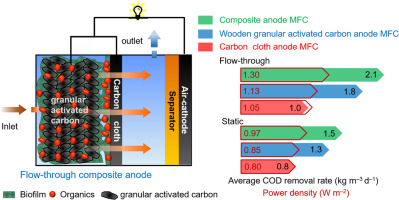Journal of Cleaner Production ( IF 11.1 ) Pub Date : 2019-04-26 , DOI: 10.1016/j.jclepro.2019.04.308 Boya Fu , Ting Xu , Xingguo Guo , Peng Liang , Xia Huang , Xiaoyuan Zhang

|
As a viable wastewater treatment and energy recovery technology, microbial fuel cell (MFC) requires more research with regard to the simultaneous achievement of high-quality effluent and high power generation. In this study, a novel flow-through carbon-based composite anode configuration is proposed, which combines the carbon cloth of two-dimensional anode with wooden granular activated carbon of three-dimensional anode. The proposed configuration enhances the performance of power production and chemical oxygen demand degradation by promoting the mass transfer, reducing internal resistance and increasing bioburden. Microbial fuel cell with the composite anode exhibited the highest maximum power density (1300 ± 50 mW m−2) and the highest chemical oxygen demand removal rate constant (0.155 ± 0.007 h−1) compared with the microbial fuel cell using the carbon cloth anode (1136 ± 46 mW m−2 and 0.072 ± 0.008 h−1) or the wooden granular activated carbon anode (1045 ± 32 mW m−2 and 0.129 ± 0.009 h−1). Meanwhile, at a lower chemical oxygen demand concentration (about 48 mg L−1), the microbial fuel cell with the composite anode maintained a current density of 2.4 A m−2, which is 18% higher than the wooden granular activated carbon anode (2.04 A m−2) and 400% higher than the carbon cloth anode (0.48 A m−2). The cyclic voltammetry and electrochemical impedance spectroscopy tests confirmed that the composite anodes displayed better electrochemical performance. Improving the flow rate and reducing the external resistance could effectively enhance the power production and chemical oxygen demand removal performance of microbial fuel cells, while the computational fluid dynamics simulation intuitively demonstrated the positive effect of the composite anode on chemical oxygen demand degradation. These results suggest that the flow-through composite anode provides a feasible strategy to simultaneously enhance the power generation and improve the effluent quality.
中文翻译:

优化和模拟基于碳的流通复合阳极配置,以提高发电效率并同时改善微生物燃料电池的出水质量
作为可行的废水处理和能量回收技术,微生物燃料电池(MFC)在同时实现高质量废水和高发电方面需要进行更多的研究。在这项研究中,提出了一种新颖的流通式碳基复合阳极结构,该结构将二维阳极的碳布与三维阳极的木粒状活性炭结合在一起。所提出的配置通过促进传质,降低内阻和增加生物负荷来增强发电和化学需氧量降低的性能。具有复合阳极的微生物燃料电池表现出最高的最大功率密度(1300±50 mW m -2)和最高的化学需氧量去除率常数(0.155±0.007 h)-1)与使用碳布阳极(1136±46 mW m -2和0.072±0.008 h -1)或木质颗粒状活性炭阳极(1045±32 mW m -2和0.129±0.009 h )的微生物燃料电池相比-1)。同时,在较低的化学需氧量浓度(约48 mg L -1)下,具有复合阳极的微生物燃料电池保持的电流密度为2.4 A m -2,比木质颗粒状活性炭阳极(高出18%)高。 2.04 A m -2)和比碳布阳极(0.48 A m -2)高400%)。循环伏安法和电化学阻抗谱测试证实,复合阳极表现出更好的电化学性能。改善流量和减小外部阻力可以有效地提高微生物燃料电池的发电量和去除化学需氧量的性能,而计算流体动力学模拟直观地证明了复合阳极对化学需氧量降低的积极作用。这些结果表明,流通式复合阳极提供了一种可行的策略,可以同时提高发电量和改善废水质量。


























 京公网安备 11010802027423号
京公网安备 11010802027423号